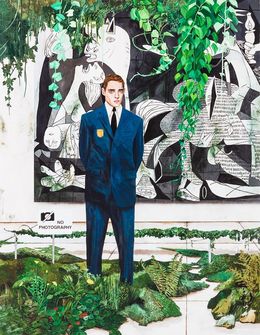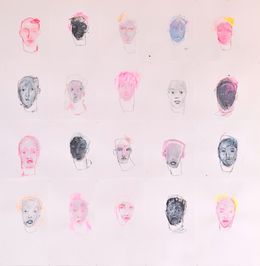
Rembrandt's late works at the National Gallery: the work of an alchemist
The late work of Rembrandt van Rijn has remarkably, never been the subject of an exhibition. The paintings, drawings and prints on display represent the culmination of the artist’s career and include his most potent works: his drawings reveal his creativity at its most raw; his etchings, his virtuosity with the burin and ability to relentlessly re-imagine a scene; and his painting, which presents such tangible life and beauty, inspires me to label him an alchemist as well as an artist.
Self Portrait, 1659
The various phases of an artist’s career have endlessly been written about, with theories being formed according to the artist’s personal development and individual circumstances, or according to universal claims on phases in all artists’ lives. The 17th century theorist Roger de Piles for instance, claimed that an artist’s career could be divided into three, the first phase consisting of a development of their teacher’s style, the second, the formation of their own style, and finally, the degeneration of an artist, increasing incompetence often explained by deteriorating health.
For de Piles this model was particularly appropriate to Titian for example, whose daringly broad handling he believed to be indicative of impaired vision. In opposition to this analysis of decline, theorists such as Vasari held the view that an artist’s oeuvre was defined by progression, and that his most mature work would therefore exhibit the greatest skill, audacity and ease of creation. Later German theorists such as Alois Riegl even made specific aesthetic claims, defining the Altersstil (older style) as a tendency toward abstraction and formal simplicity, along with greater depth in subjective and intellectual content.
In our contemporary age, the concept of an Altersstil seems either prescriptive, or distinctly inapplicable to the most part of art produced in the 20th century. Nonetheless, I find it an interesting observation in the manner it makes an attempt to grasp the nature of ageing, and how despite our differences, humanity is united by a similar attitude to life, and death when it appears to be imminent.
Heavy stuff? I suppose. But Rembrandt’s mature work necessarily engages in philosophical questioning, which he displays both in the nature of subjects and of his endlessly experimental technique. The artist received mixed reviews posthumously, but today his late style is unquestionably praised for a host of factors. The viewer cannot help but be struck by his ability to illuminate and cast in shadow all of his subjects, endowing the scene with remarkable spatial and temporal specificity, yet simultaneously casting the sitter in an indistinctive otherworldly realm, such is the intensity and unique beauty of the light. The subtlety of illumination works in tandem with the artist’s unendingly expressive technique, his ability to render form and expression so convincingly and so variously. All of his works are unmistakably Rembrandt, yet the difference between each is marked.
Further, the artist was inspired by a plethora of visual sources, his undiscriminating eye selecting a range of subjects, honouring the ugly or mundane as much as the mythological and beautiful. He believed in truth to nature, unlike artists creating alongside him who tended towards baroque opulence. As a result, Rembrandt was privy to the gamut of human emotion, illustrating the unique harmony of love, or the torment of suffering, with sincerity and unflinching honesty.
The exhibition is organised thematically, classifying works executed from the early 1650s to his death in 1669 according to technique and subject. I found the space cleverly divided, creating interesting links between works, and making Rembrandt’s rich oeuvre easier to define.
The first room piques the visitor’s curiosity with five self-portraits. The first, painted in 1659 is deeply engaging as the artist’s penetrating gaze suggests a dialogue with the viewer: we are given a glimpse of his character and at the same time he appears quizzical and interested in the onlooker. A century seems to have passed between this portrait and the last portrait painted the year of his death, in 1669. The artist seems to have exaggerated his age as he depicted himself haggard, his flesh having lost its vital complexion and elasticity. His gaze is now almost absent and detached, conveying a dissipating desire to live. Indeed, Rembrandt suffered professional setbacks and the loss of his lover and son during this period. It is unsurprising his health took a turn for the worse.
Rembrandt must have drawn from personal experience when he painted Lucretia in 1666, three years after the death of his lover. The dramatic legend of Lucretia recounts how she killed herself after having been raped, unable to bear the shame. Rembrandt depicted Lucretia soon before her death, after having plunged a dagger into herself. Her youthful face and forlorn expression render this work particularly poignant. Her tangibility is characteristically emphasized by the artist’s handling, her delicate skin contrasted with the heavy brocade of her sleeves.
Lucretia, 1666
The artist’s taste for the graphic and visceral is boldly apparent in The Anatomy Lesson of Dr Joan Deyman, 1656. Here scientific investigation is being carried out on a dead body. A figure on the right holds the neatly cut top half of the dead man’s skull, while another concerns himself with spooning out bloody matter from his brain. Bit vivid? Wait until you see it.
More than blood and guts, this work self-consciously references the art historical canon, the heavily foreshortened figure particularly reminded me of the quattrocento Renaissance artist Mantegna, and his painting of the Dead Christ c.1480. Rembrandt referenced later Renaissance artist’s such as Titian, with the Dutch master’s painting of Juno c.1662-5 quite evidently relating to the Venetian’s portrait of ‘La Schiavona’, c.1510-12. Rembrandt emulated the stature of Titian’s portrait, his elaborately dressed goddess of love and marriage standing proud and gazing out with compassionate brown eyes.
Compassion and tenderness are the subject of one of Rembrandt’s most well known paintings, Portrait of a Couple as Isaac and Rebecca or ‘The Jewish Bride’, c.1665. Rembrandt’s mastery is plain to see as he was able to evoke the unfaltering mutual understanding between a couple in love. Such a depth of feeling is conveyed by the simple and modest gesture of his hand placed gently over her heart, and hers over his.
For its similarly tender portrayal, I was drawn to the portrait of the artist’s son Titus in Monk’s Habit, 1660. The artist portrayed the young man lost in contemplation, appropriate to the Franciscan way of life where solitary retreat is a central tenet. There is an unmistakable sense of intimacy as the artist suggests the sitter could well be unaware of being watched. I found this picture very moving as the viewer is invited to imagine looking at this young man through the eyes of a proud father.
Thought-provoking and a feast for the eyes, this show is truly a rare opportunity.

About Artsper
Founded in 2013, Artsper is an online marketplace for contemporary art. Partnering with 1,800 professional art galleries around the world, it makes discovering and acquiring art accessible to all.
Learn more















